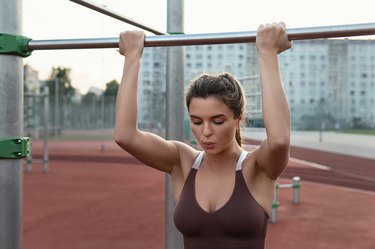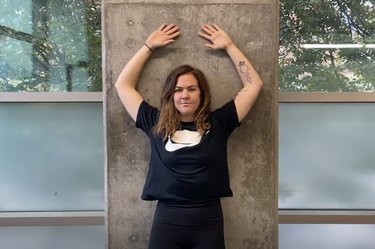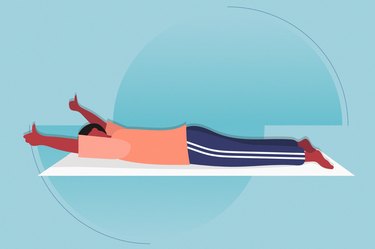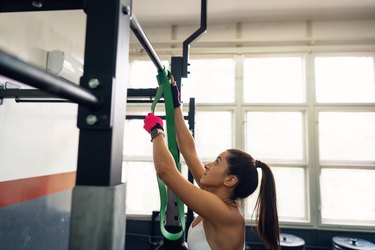

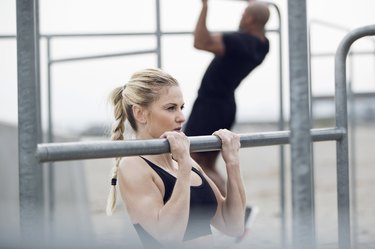

Ranking right up there with push-ups and burpees as the top exercises that people love to hate, chin-ups might look like a pure arm exercise.
But as you learn how to do a chin-up — and all of the muscles that are involved — it quickly becomes clear that it's one of the best total-body strength exercises ever. And there's nothing quite as satisfying as peeking over that bar for the first time.
Video of the Day
- What is a chin-up? It's a challenging body-weight exercise in which you hang from an overhead bar with an underhand grip, then pull through your back and arms to raise your chin over the bar.
- What muscles do chin-ups work? They primarily work the lats, upper back, shoulders and biceps, but also engage the triceps, core and even glutes, says Joshua Honore, CPT, a certified personal trainer with Row House GO in San Diego.
- Who can do this exercise? Any injury-free exerciser can do a chin-up, according to Jessica Mazzucco, CPT, founder and head trainer of The Glute Recruit in Scarsdale, New York. There are tons of ways to modify the move to fit any ability level. (More on them below.)
- What's the difference between chin-ups and pull-ups? With pull-ups, your palms face away from you. During chin-ups, your palms face toward you, she says. That grip ultimately determines which muscles you prioritize and how hard the exercise is.
How to Do Chin-Ups With Perfect Form
- Approach a secure, sturdy bar with your arms about shoulder width apart and hips tucked under.
- Grab the bar with an underhand grip, your palms facing toward your body.
- Squeeze your lats, core and glutes to make your body as rigid as possible
- Start the exercise at the shoulder blades by pulling them down and together. Squeeze your upper back then use the biceps to pull yourself up, keeping your hips tucked under.
- Once your chin is over the bar, or as high as possible, carefully reverse the move until your arms are fully extended at the elbows and shoulders.
- Repeat for the desired number of reps.
Watch the Full Tutorial
"Consistency and frequency pay off big. Commit to practicing on a regular basis, even if it's with just a few reps. Doing this twice or three times per week should be enough to see significant improvement within just a few weeks."
Chin-Up Benefits and Muscles Worked
Chin-ups are one of the best body-weight exercise to build strength in your arms, shoulders and core.
"They work nearly every muscle of the upper back, including the lower trapezius, latissimus dorsi, rhomboids, teres, subscapularis, rear deltoids and biceps muscles," Honore says. They even work the long head of the triceps, which connects to your shoulder.
Plus, chin-ups improve forearm strength, which leads to greater endurance and strength in other barbell and dumbbell exercises such as lat pull-downs, barbell curls, snatches and more. Increasing your grip strength also helps you functional exercise movements — say, rope climbs and jumping rope — as well as everyday activities, including lifting and carrying heavy loads of groceries.
According to the American Council on Exercise (ACE), the main chin-up muscles include:
- Biceps brachii: AKA your biceps, these help lift your body from a straight-arm hang to over the bar.
- Brachialis and brachioradialis: These forearm muscles grip the bar and don't let go.
- Latissimus dorsi: This mid-back muscle pulls your shoulder blades down and together, and are the primary muscle worked in the exercise.
- Pectoralis major: This chest muscle keeps your elbows and arms pulled in toward you body to help you move most efficiently.
- Trapezius: The traps help move your shoulder blades so you can raise you body
- Teres major and minor: Spanning the back, the teres muscles assist your lats and traps.
- Posterior deltoid: The rear delt muscle, it and helps keep the shoulders in an effective (and safe) position.
- Deep spinal stabilizers: These hang out around the spine and keep it in proper alignment throughout the move.
Still, it's important to realize that, when done properly, the chin-up exercise is a true total-body builder. Getting yourself up and over the bar demands total-body tension or, put most simply, squeezing every muscle you've got. Keeping a rigid torso with your core braced and glutes tight helps power your pulls.
As Honore explains, the exercise even helps combat upper-crossed syndrome, a condition in which upper-body strength imbalances negatively affect posture.
So while the body-weight move is excellent for build upper-body muscle and strength, it will truly help you develop your entire body while teaching it to work as one cohesive unit. That means improved all-around athleticism, coordination and power.
What's the Difference Between a Chin-up and Pull-Up?

"Both chin-ups and pull-ups are great body-weight exercises that can help improve the strength and function of the shoulder girdle," Honore says. They involve a very similar movement flow, but are different in three main ways.
1. Hand Position
The foundational difference between chin-ups and pull-ups is how you hold the bar. During chin-ups, you hold the bar with an underhand grip, palms facing toward you. During pull-ups, you hold the bar with an overhand grip, palms facing away from you.
To hold the bar with an underhand, or supinated, grip in chin-ups, you have to use a more narrow grip than you do with pull-ups.
2. Muscles Worked
While both exercises work the same muscles, how you hold the bar affects which of those muscles you target the most. Chin-ups put more focus on the biceps, while pull-ups emphasize the upper back.
So if you want more of a biceps boost out of your workout, opt for going chin-to-bar.
3. Difficulty
Because chin-ups let you use your biceps to your lifting advantage, they are "easier" than pull-ups, which don't get as much assistance from your biceps.
If someone can do 5 chin-ups, they can generally rock around 3 pull-ups.
3 Best Chin-Up Bars for At-Home Workouts
- Rogue Jammer Pull-Up Bar (RogueFitness.com, $120)
- Iron Gym Chin-Up Bar for Doorway (Amazon.com, $29.46)
- Perfect Gym Portable Pull-Up Bar (Amazon.com, $34.99)
Note: Pull-up bars and chin-up bars are the same thing and can be used for both exercises.
5 Tips for Stronger Reps

1. Start With Assistance
When working up to your first unassisted chin-up — or if you want to rock more reps than you're able to on your own — use a long looped resistance band to do the exercise assisted.
Loop the band around the bar and place your foot into the base of the band. That way, it will support some of your body weight. Many brands offer packs with a wide variety of band thicknesses to support different weights.
Alternatively, you can use an assisted chin-up machine, Honore suggests. These are slightly easier to use, but less helpful at building your strength compared with band-assisted reps.
2. Get on a Bench
Stand on a sturdy bend or box to help you initially reach the bar. If you're a beginner, keep it close by and perform negative repetitions (see below) to build to strict reps.
3. Use Your Whole Body
"Always engage your core and glutes — they are the powerhouses of the body and will help you to recruit more muscle during the exercise," Mazzucco says.
4. Warm Up First and Stretch Often
Upper-body flexibility and mobility is crucial to keep the exercise safe on your shoulders. Before doing the move, do dynamic warm-up exercises like band pull-aparts and shoulder circles or dislocates, Mazzucco says.
Throughout the week, perform upper-body stretches for 30 seconds each before bed or after your workout.
5. Make it a Habit (but Allow for Rest)
"Consistency and frequency pay off big," Honore says. "Commit to practicing on a regular basis, even if it's with just a few reps. For strength gains, I recommend working up to 2 to 3 sets of 5 to 10 reps. Doing this twice or three times per week should be enough to see significant improvement within just a few weeks."
That said, the exercise demands a lot of energy and strength. So aim to do it at the beginning of your workout when you're fresh. Start off slow (like with 1 or 2 reps per set) and take a rest day between each day you practice your pulls, Mazzucco adds.
2 Modifications to Make It Easier
Move 1: Band-Assisted Chin-Up
These are a perfect beginner chin-up exercise. "We are all different shapes, sizes and strengths. Utilizing bands helps even the playing field, giving us a bit of help getting to a productive rep range," Honore says.
Throw a band over the bar and pull one end through the middle of the other end to create a resistance band loop. Place either or both feet or knees through the loop of the band to support some of your body weight.
Move 2: Negative Chin-Up
With negatives, you do only the eccentric, or lowering, part of the exercise. "Negatives help bring the muscle close to failure but with less fatigue on the body," Honore says.
Standing on a bench or box, hold onto the bar, then jump up to so that your chin is over the bar. Then slowly and carefully lower your body down until elbows and shoulders are fully extended. Put your feet back on the bench and repeat.
2 Progressions to Make It Harder
Move 1: Tempo Chin-Up
To take a regular chin-to-bar to the next level, slow things down. Rather than going through the motions quickly, count 3 to 5 seconds on the way up, hold for 1 second at the top, and count 3 to 5 seconds on the way down.
"Time under tension is a variable that contributes heavily to muscle growth and strength development," Honore says.
To build power and strength all at once, you can also consider going fast on the way up, holding at the top for 1 second and slowly lower down for 3 to 5 seconds.
Move 2: Weighted Chin-Up
Once you can perform 10 unassisted reps with proper form, consider using a weighted vest or waist belt with a weight plate to make them more challenging. Everything about the movement remains the same — the additional resistance simply makes it a lot tougher.
"Increasing the load allows you to continue to increase strength," Honore says. "With weighted reps, a little goes a long way. Adding just 10 to 15 pounds can dramatically increase the difficulty of the exercise."
Was this article helpful?
150 Characters Max
0/150
Thank you for sharing!
Thank you for your feedback!
